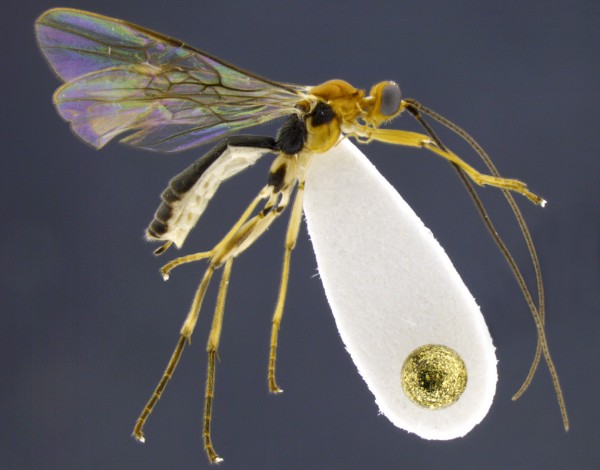We're open daily! View holiday hours
Science News
Famous Mummy Wasps
May 28, 2014
by Molly Michelson

Are Jimmy Fallon, Jon Stewart, Stephen Colbert, Ellen DeGeneres, and Shakira all parasites? Not in their human forms, of course, but as species of the genus Aleiodes, or mummy wasp, they most certainly are.
These Ecuadorian cloud forest insects are small (4 to 9 millimeters long), vicious creatures. The female wasps search for a particular kind of caterpillar, and inject an egg into it. They are too evil to kill the caterpillar immediately. No, the wasp larva continues to feed and grow for a few months inside the unsuspecting caterpillar. Eventually, the host shrinks and mummifies, and the immature wasp makes its cocoon inside the mummified remains.
When it completes its development, the young wasp cuts an exit hole from the caterpillar mummy and flies away to mate and continue this cycle of parasitic behavior. Mwahahahaha.
But entomologist Scott Shaw, of the University of Wyoming, says mummy wasps’ actions aren’t as evil as they sound. Shaw, who happens to be writing a book about parasitic wasps, says they actually benefit forest ecosystems. “These wasps are helping to naturally control the populations of plant-feeding caterpillars, so they help to sustain the biodiversity of tropical forests,” he says.
The newly- and famously-named wasps were published last month in Zookeys and join several other mummy wasps around the world. Shaw and Brazilian colleague Eduardo Shimbori discovered the insects at the Yanayacu cloud forest research station of Napo Province, in the eastern Andes slopes of Ecuador.
And perhaps you’re wondering why the Shakira wasp wasn’t named after a talk show host? Aleiodes shakirae causes its host caterpillar to bend and twist in an unusual way, which reminded the authors of belly-dancing, for which the Columbian performer is famous.
Image of Shakira wasp: Eduardo Shimbori